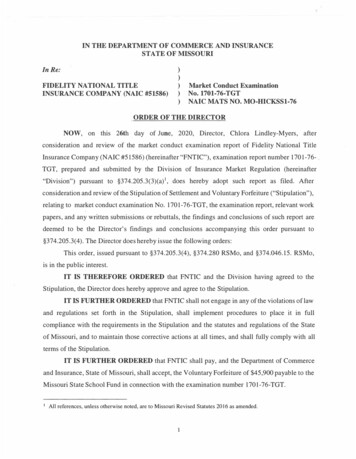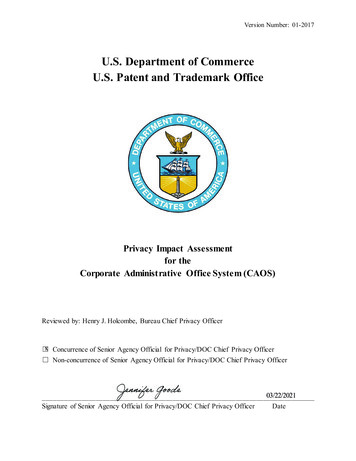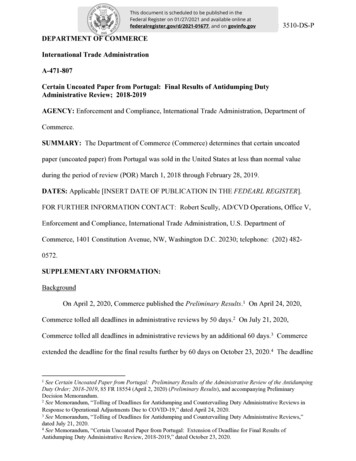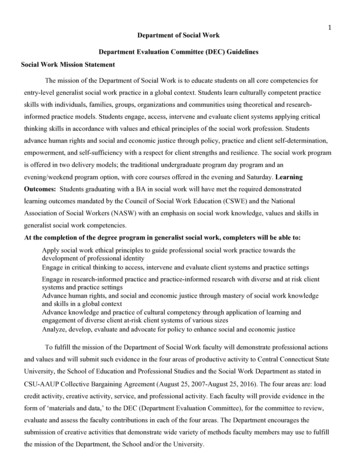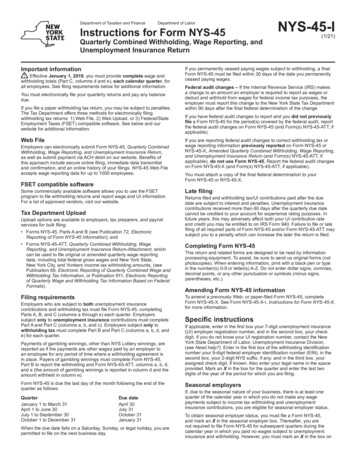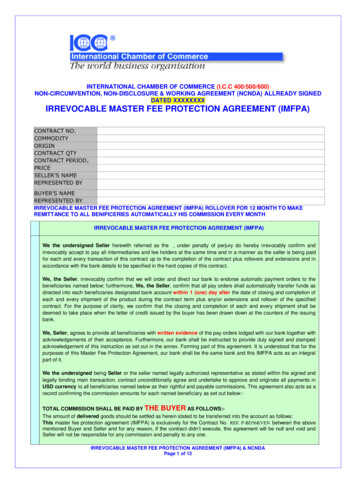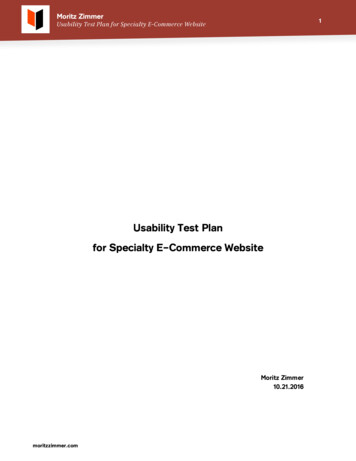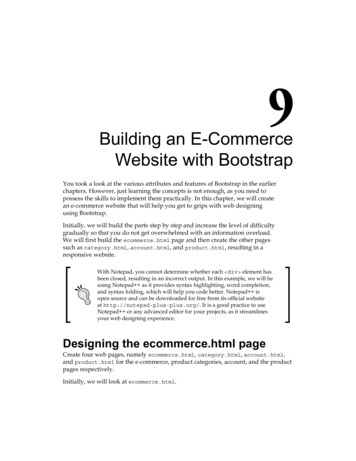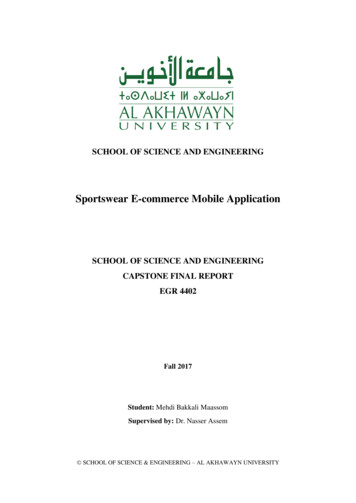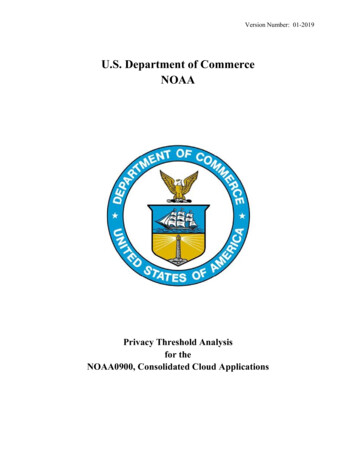
Transcription
Version Number: 01-2019U.S. Department of CommerceNOAAPrivacy Threshold Analysisfor theNOAA0900, Consolidated Cloud Applications
Version Number: 01-2019U.S. Department of Commerce Privacy Threshold AnalysisNOAA0900/Consolidated Cloud ApplicationsUnique Project Identifier: 006-48-02-00-02-0000-00Introduction: This Privacy Threshold Analysis (PTA) is a questionnaire to assist withdetermining if a Privacy Impact Assessment (PIA) is necessary for this IT system. This PTA isprimarily based from the Office of Management and Budget (OMB) privacy guidance and theDepartment of Commerce (DOC) IT security/privacy policy. If questions arise or furtherguidance is needed in order to complete this PTA, please contact your Bureau Chief PrivacyOfficer (BCPO).NOAA0900 is a consolidated accreditation boundary for multiple existing NOAA cloudapplications, as well as any new cloud applications. NOAA Consolidated Cloud Applications’component cloud applications are distributed among multiple Cloud Service Providers (CSP).NOAA OCIO offices are located at the Silver Spring Metro Center (SSMC) campus in SSMC3at 1315 East West Highway, Silver Spring, Maryland and is a General Support System.This is an aggregated system with multiple applications, which are connected through NOAAnetworks to various Cloud service Providers. These applications are as follows:Application NamesATO statusFIPS-199 CategorizationEverbridge Suite (EBS)FedRAMP ATOMODERATEG-SuiteFedRAMP ATOMODERATEMass 360FedRAMP ATOMODERATEServiceNowFedRAMP/NOAA ATOHIGHSmartSheetFedRAMP ATOMODERATEIvantiNOAA approved, FedRAMPReadyMODERATEAODocsNOAA Approved/FedRAMPMODERATE in processMODERATE/FedRAMPMODERATE in processMS DynamicsDOC approved ATOHIGH2
Version Number: 01-2019ESRIFedRAMP (Dept of Interiorapproved) ATOLowVirtruFedRAMP ATOModerateSee respective NOAA0900 component applications PIA documentation contained inapplications’ ATO packages for specific details on information collected.EBS: Everbridge Suite (EBS) is a Software-as-a-Service platform that is used for managingcritical events. Federal Agencies and other organizations use EBS platform for operationalresponse to critical events in order to keep people safe and businesses running faster. Duringpublic safety threats such as active shooter situations, terrorist attacks or severe weatherconditions, as well as critical business events such as IT outages, cyber-attacks or other incidentssuch as product recalls or supply-chain interruptions, the EBS system functions to quickly andreliably aggregate and assess threat data, locate people at risk and responders able to assist,automate the execution of pre-defined communications processes, and track progress onexecuting incident response plans. Many Federal agencies utilize EBS as part of their employeecommunication strategy – for agency’s contingency planning and business continuity, staffaugmentation, and IT alerting needs. It is built on multi-tier architecture within Amazon WebServices’ public cloud infrastructure in East/West regions which are FedRAMP compliant.EBS collects the following information: name, work phone number, work cell phone number,work email address, and work mailing address.G-Suite: Google Suite, a PaaS provider, supplies mail/calendar and Google drive services toall NOAA staff, is also integrated into NOAA0900.The Google Services offering consists of two primary layers; Google Cloud Platform (GCP) andGoogle Common Infrastructure (GCI). The Google Cloud Platform contains 49 customer facingservices. The services within the Google Cloud Platform sit on top of Google CommonInfrastructure, which is infrastructure private to Google that is responsible for theimplementation of common controls for all Google service offerings. These two pieces worktogether to provide the Google Services offering.GCP is an extensive suite of products from Google-controlled development environments (e.g.Google App Engine) to customer-managed environments (e.g. Google Compute Engine) offeringflexibility via fully customizable virtual machines and utilization of other services like fully-managed databases and data analytics tools, networking services including virtual load balancing and virtual private cloud solutions, access management tools,3
Version Number: 01-2019 Cloud project management tools, machine learning capabilities, and developer tools.GCI is private infrastructure, utilized only by Googlers and Google-developed software, whileGCP is a public hybrid cloud that is hosted on GCI, serving the US Federal Government,personal users, and other organizations. GCI is responsible for implementation of commoncontrols for all Google service offerings, including GCP. Customers have no direct access toGCI, but interaction with Google’s IaaS/PaaS/SaaS offerings (like GCP) result in traffic and datain GCI.Google maintains a private cloud Infrastructure as a Service (IaaS), GCI, upon which its productofferings are built. Per the NIST SP 800-145 definition of a Private IaaS Cloud, the GCI isrestricted to Googlers and consists of multiple reusable services such as databases, computeservices, management tools, and security controls of which all Google services can takeadvantage. Abstracting these components to a common layer means that Google can applyconsistently strong data protection and security controls across all service offerings. In additionto providing a technical infrastructure for products to run, GCI provides common processes suchas security training, change management, secure software development lifecycle (SDLC),vulnerability management, and risk management. This is fundamentally different from the wayother companies develop software and gives Google an advantage when it comes to uniformmanagement of its products where each product inherits security technology, controls andprocesses from GCI. Google Cloud Platform runs on top of the Google Common Infrastructure.The Google Common Infrastructure consists of four components: Network,Data centers,Resource management, andData StorageThe Google Cloud Platform (GCP) is comprised of IaaS, PaaS and SaaS offerings that sit on topof Google Common Infrastructure. GCP offers a combination of services ranging from a fullycustomer managed virtual infrastructure and associated storage/DB and networking services thatallow customers to provision fundamental computing resources from the operating system up thetechnology stack (Google Compute Engine) (IaaS), to a CSP-managed platform for deployingapplications onto the cloud without having to manage the underlying infrastructure (Google AppEngine) (PaaS), to system management tools and advanced Machine Learning API’s.G-suite collects email logs, authentication logs, basic user information, device information,calendar logs, and drive logs. G-suite does not collect PII or BII.MaaS 360: MaaS360, a SaaS provider, configures mobile devices using the DoD SecurityTechnical Implementation Guide (STIG) cybersecurity baseline. MaaS360 offers scale, control4
Version Number: 01-2019and security across all devices and mobile platforms, providing total device management by user,device, application, and across an enterprise. As a fully integrated cloud platform, MaaS360delivers Mobile Device Management (MDM) as well as desktop and laptop management tocustomers.MaaS360 embodies the following five essential cloud characteristics defined by NIST SpecialPublication (SP) 800-145 “The NIST Definition of Cloud Computing”: On-demand self-service environment, Broad network access is supported, Resource pooling and multi-tenancy is core to the design, Capabilities can be rapidly and elastically provisioned, and Measured service principles are implemented with resources automatically controlledand optimized.The cloud computing service delivery model MaaS360 is SaaS model. In this delivery model,IBM is responsible for all of the service delivery layers including; infrastructure (i.e., hardwareand software that comprise the cloud infrastructure); data security, and service managementprocesses (i.e., the operation and management of the infrastructure and the system and softwareengineering lifecycles). Federal agencies are responsible for managing the customer configurableoptions, for authorizing, granting and reviewing administrator access and for reviewing loggedactivity.MaaS360 is a system that customers can use to monitor and control the security posture of theirdesktop and laptop computers and also of other items in their mobile device inventory, such assmart phones and tablet devices. For MaaS360 to monitor and control devices, each manageddevice needs to be registered with MaaS360 and then must periodically connect to MaaS360both in order to update MaaS360 with current device status and with any relevant events and alsoto receive security configuration updates from MaaS360. Although at a basic level, this servicedelivery concept is the same for all managed devices, the mechanisms used vary for differenttypes of devices.IBM customers use the MaaS360 Portal, a cloud-based management console, to manage thesecurity of desktop and laptop computers and other mobile devices such as smart phones andtablet devices. For each customer organization, at least one user is given administrator access toconfigure, monitor, and manage the organization’s implementation of MaaS360 using theMaaS360 Portal.MaaS360 collects basic user information and basic device information. MaaS360 does notcollect PII or BII.5
Version Number: 01-2019Service Now: ServiceNow, a SaaS provider, is an application hosted at Terremark facilities inManassas, VA and Miami, FL. It is an appliance-based solution for remote support to desktops,laptops, and other approved devices.The ServiceNow product is a suite of natively integrated applications designed to support ITservice automation, resource management and shared support services. ServiceNow is built onmodern web technologies. The ServiceNow platform includes easy-to-use, point-and-clickcustomization tools to help customers create solutions for unique business requirements.ServiceNow applications cover all Information Technology Infrastructure Library (ITIL)processes and are natively integrated on a single platform providing web intuitiveness anunprecedented process automation.ServiceNow is a modular solution, meaning that customers may use all, or a sub-set of theapplications provided via ServiceNow. Additionally, these applications may be implemented in amodular fashion.A ServiceNow SaaS application is a group of modules, or pages, that provide related informationand functionality in a ServiceNow instance. For example, the Incident application containsmodules for creating and viewing incidents; the Configuration application contains modules forconfiguring servers, databases, and networks. The Application Navigator (or left-navigation bar)within the ServiceNow user interface, provides links to all applications and the modules theycomprise enabling users to quickly find information and services. Administrators can customizethe Application Navigator to provide different modules by user role, modify or defineapplications and modules, and change its appearance. These SaaS applications can be added orremoved by enabling or disabling the application‘s Plugin.The ServiceNow Service Automation Government Cloud Suite is physically and logicallyseparated from the ServiceNow Public Cloud offering. The ServiceNow Service AutomationGovernment Cloud Suite is hosted in two dedicated data center cages that house infrastructurededicated to the Government Community Cloud. Logically, ServiceNow‘s network architectureand access controls separate the ServiceNow Government Community Cloud from theServiceNow Public Cloud. ServiceNow single-tenant environment ads an additional layer oflogical separation for instances.Federal customers share a hardware platform (no virtualization), but access entirely separateindividual instances of the ServiceNow platform located in the dedicated federal data centercages. Each individual instance connects to a database only accessible by that specific instance.The ServiceNow Service Automation Government Cloud Suite consists of the out-of-the-boxapplications in addition to the ServiceNow Discovery Application and ServiceNow Orchestration(Orchestration) Application. The ServiceNow Discovery Application and ServiceNowOrchestration (Orchestration) Application are sold separately from the ServiceNow out-ofthebox applications. The ServiceNow Discovery Application and ServiceNow Orchestration6
Version Number: 01-2019Application are not required for the system to operate or relied on for security controlimplementation. Thus, if not purchased the system security is not negatively impacted. Allapplications in the table below are general applications part of the ServiceNow ServiceAutomation Government Cloud Suite within the testing scope of the FedRAMP authorization.ServiceNow collects user information such as name, user information related to injuries, deaths,incident information, and mishaps that occur to those users, and IT Ticket information.Smartsheet: Smartsheet provides a cloud collaboration platform to enable users to plan,capture, manage, automate, and report on work while utilizing various collaboration features.Smartsheet projects provide essential tools for project management.Various features within the application include project tracking, smart grids, calendars,dashboards, cards, portals, forms, automations, and control center.Smart projects allow users to manage every aspect of complex projects, and visualize tasks inGantt, card, and calendar views. Smart grids provides a unified, customized view of projects thatkeeps teams on task and on time to easily track multiple moving parts. Smart calendars keepteams in sync with an interactive, comprehensive view of all activities and critical timelines.Smart dashboards provide project owners and stakeholders a real-time view into the status of topkey performance indicators, critical trends, and summary reports. Smart cards give teams a morevisual way to communicate and collaborate in Smartsheet. Smart portals bring teams togetherand keep them on the same page with an easy-to-create and maintain centralized informationportal. Smart forms empower business users to speed execution and foster innovation by makingit easy to collect and act on data. Smart automations put simple and powerful work processautomation rules to work in a matter of minutes.Smartsheet utilizes two (2) AWS VPCs (Management VPC and Product VPC) to controlcommunications to the Smartsheet Gov. environment. The external boundary is monitored andcontrolled at three separate locations, two access paths (bastion host and Windows jump host)and for the Management VPC and one access path (AWS ALBs) to the Product VPC. TheManagement VPC is accessible only to Smartsheet personnel via strict routable access(Corporate IP whitelisting) and a valid access authorization. Smartsheet administrators utilize anOpenSSL VPN (TLS 1.2) from the corporate network to connect to a jump host (AD YubiKeycredentials) in the Management SG. The Bastion Host is a Red Hat Enterprise Linux (RHEL)Server configured with FIPS 140-2 validated modules (please see SC-8 for certificate numbers)for OpenSSH and OpenSSL. From the bastion/jump host, administrators can either RDP or SSHto the instance they need to manage within the Smartsheet Gov. environment. Access to theProduct VPC is restricted to HTTPS only and is routed through AWS ALBs to handle the TLStermination of customer sessions to the Smartsheet Gov. Application.Within the Management VPC each application is within its own AWS Security Group. Forexample, the vulnerability scanning tool and Sherlock ELK are separated into dedicated AWS7
Version Number: 01-2019SGs. Similarly, within the Product VPC each component supporting an application such as CoreApp are separated into AWS SGs. Individual components performing the same function aregrouped within the same AWS SG (i.e. Core APP RDS DBs). Communication between theManagement VPC and the Product VPC is accomplished via AWS VPC peering. Allauthentication across the boundary requires an MFA token.Smartsheet Gov. connects to an array of corporate services and a single external service.Smartsheet utilizes Lucidchart to create the initial set of diagrams. There is no connectionbetween Lucidchart and Smartsheet Gov. Smartsheet has a contract with DocuSign to handlecustomer acknowledgement and signature acquisition prior to onboarding personnel. NetSuite isdeployed within the corporate environment and is utilized for enterprise resource planning.Salesforce is utilized by Smartsheet corporate personnel to manage financial relationships withcustomers and perform customer relationship management (CRM). Slack has been implementedto support interoffice communications. Finally, Gmail is used for general email services withinthe corporate environment. Smartsheet enforces via policy to prevent the communication ofcustomer data and/or information within corporate services.The single external service for the Smartsheet Gov. environment is PagerDuty. Smartsheetcontracts with PagerDuty to perform alerting of relevant Smartsheet Gov. Points of Contact(POC) for escalating issues within the environment. No sensitive or customer data is sentthrough the PagerDuty alerts. PagerDuty alerts send only the message that the relevant usersmust log into the Smartsheet Gov. environment to check on the status of an emerging incident.Smartsheet collects the following information: Administrative DataFinancial Administration (IT Acquisition workflows)IT Ticket System (Help Desk)Project/Program ManagementSmartsheet does not collect PII or BII.Ivanti: Ivanti Service Manager (ISM) is a cloud-based IT Service Management (ITSM)solution. ISM is designed to be the central point of contact between users, employees and the ITorganization. It offers first and second line support to users, where incidents, problems orinaccuracies in IT systems are reported. ISM can also be an important source of managementinformation for reporting and auditing purposes. ISM fully supports Incident, Problem, Changeand Release Management, Self-Service, & 3rd party integration. Ivanti’s software is used byFSD (Finance Systems Divison) to provide and monitor help desk support and manage internalFSD configuration and management requests.The authorization boundary of the Ivanti Service Manager (ISM) consists of the AWS East/WestVirtual Private Cloud (VPC) to host multi-tenant environments, an Ivanti Management VPC to8
Version Number: 01-2019host management and security tools, AWS Management Console for administration of the of themulti-tenant environments, and external cloud systems to support the ISM productionenvironment such as Qualys Cloud. Additionally, Ivanti includes AWS services such as EC2, S3,CloudTrail, and etc. to be in the authorization boundary. These virtual system environmentswithin AWS, AWS services, and external cloud systems constitute the authorization boundary byIvanti as they store, process, and/or process customer information.The system components that make up ISM are hosted within the AWS US East/West datacenterfacilities. Ivanti relies on AWS to provide appropriate physical and logical protections andprocesses for the AWS datacenter facilities. For the purposes of FedRAMP, the AWS datacenterfacility will be considered a leveraged, authorized service provider. The AWS datacenter facilitywill not be assessed by the 3PAO during assessment activities.Customer users are able to log into their ISM web application tenant environment using theirown organization credentials. Using SAML technology, customer can federate their webapplication to their internal account management infrastructure to access the ISM environment.This access method includes the acceptance of PIV/CAC credentials.The ISM authorization boundary does not
Technical Implementation Guide (STIG) cybersecurity baseline. MaaS360 offers scale, control . Version Number: 01-2019 5 . granting and reviewing administrator access and for reviewing logged activity. MaaS360 is a system that customers can
